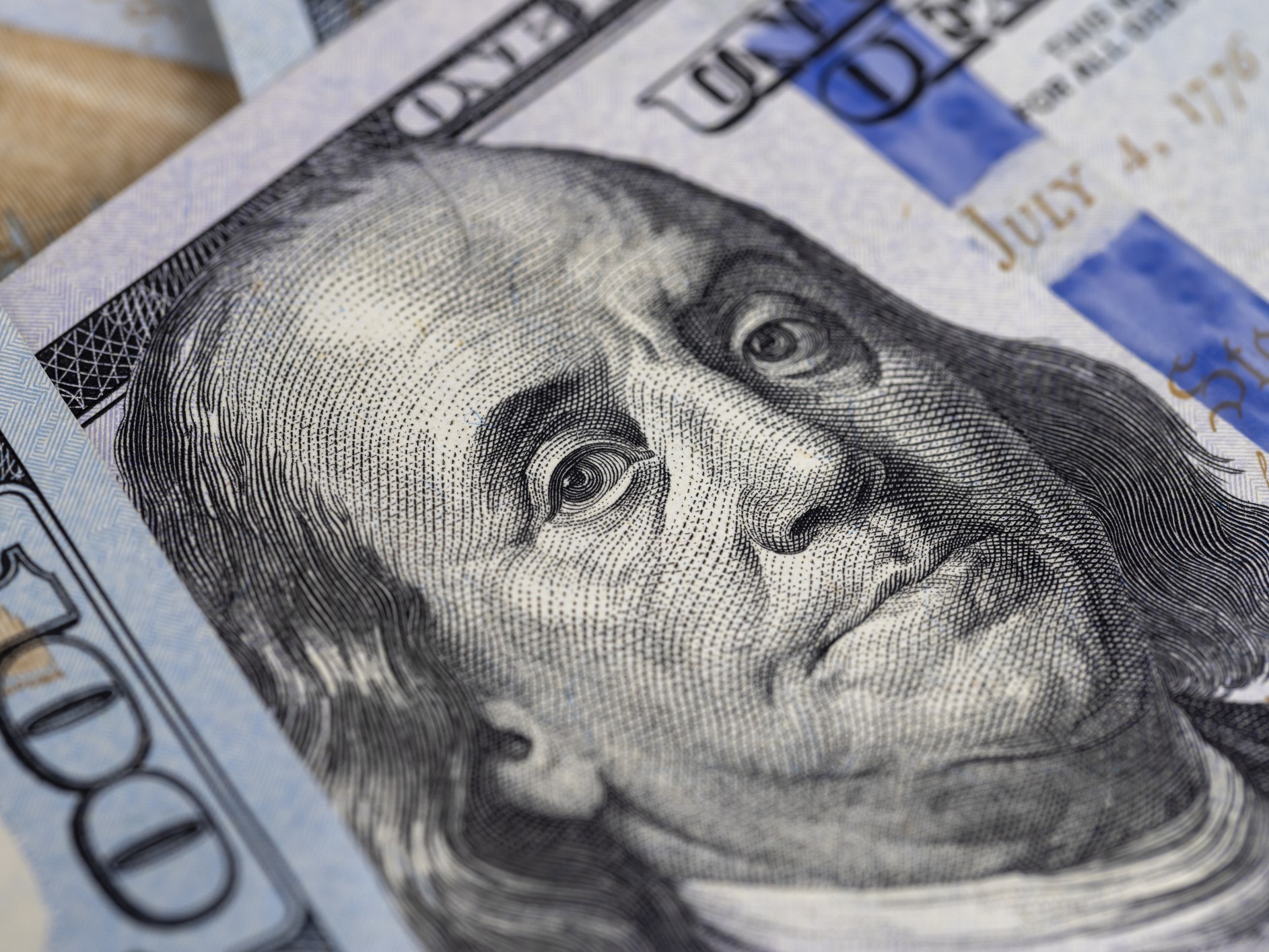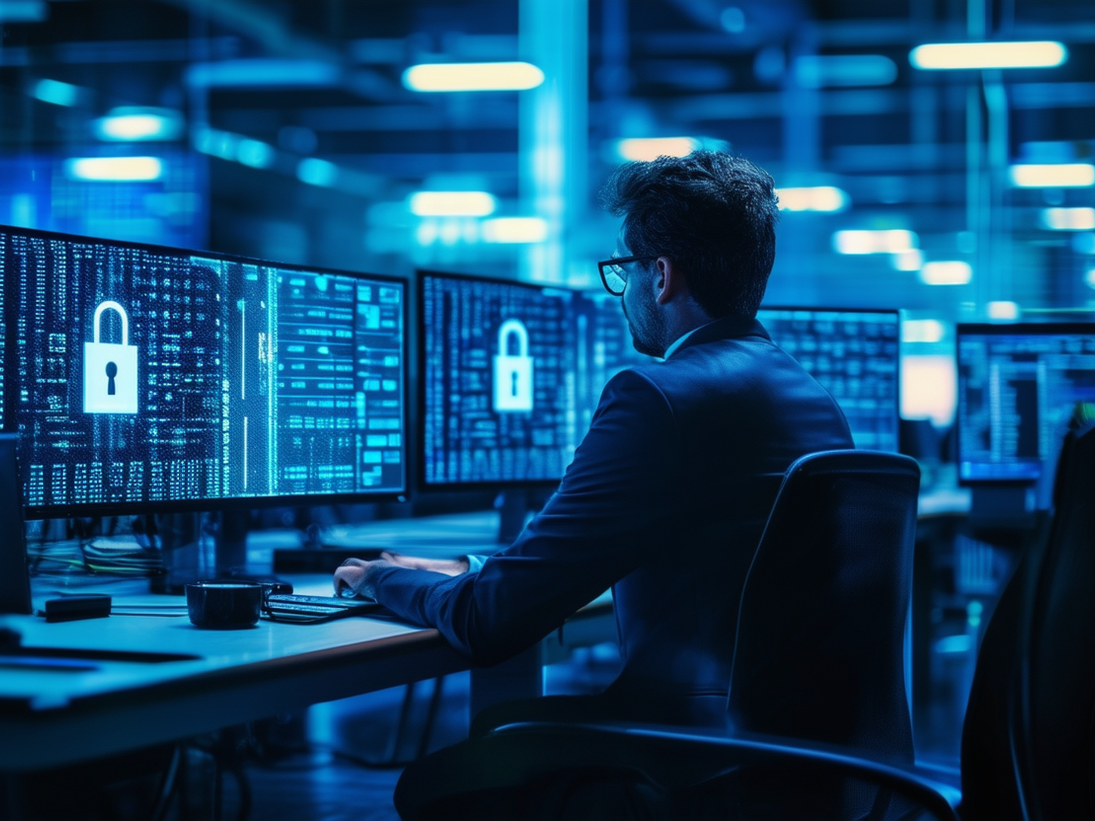The Trials and Triumphs of a Workplace Injury: A Workers’ Comp Professional’s Harrowing Journey Through the Workers’ Comp System

Picture this: San Antonio, with its beautiful River Walk, Tex-Mex food around every corner, and a conference center large enough to host those in-person events we’ve all been missing for the better part of two years.
When Michelle Despres landed in the city from Jacksonville, Fla., her eyes were set on the big prize: Three whole days of in-person events for the annual American Physical Therapy Association’s (APTA) conference, held February 2-5 this year.
As the vice president of product management and national clinical leader for physical therapy at One Call, Despres was looking forward to the lessons APTA 2022 was bound to provide. Little did she know, the biggest lesson would come from the city streets themselves.
“San Antonio had experienced unprecedented winter weather,” she recalled.
The roads were wet that chilly afternoon of February 3. Despres reminded herself to walk with caution, because even though it did not appear like it, ice could be a possibility.
“I had crossed this particular crosswalk many times, because I had been at the conference a couple of days early for meetings,” she said. “When I went to cross, the light was green. I didn’t need to slow down, stop or wait. I kept walking at a rapid clip and stepped off the curb. As soon as my foot hit the ground, I slipped. I heard the snap; I felt the snap.”
Afternoon, Day One: Alone, Broken Bones, Pain Management, Initial Report of Injury
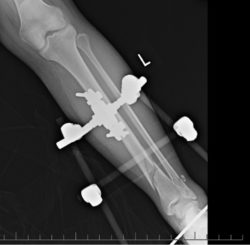
Despres’ left leg with splint and pins in place.
Her leg broke, shattered to the point that one physician later told her it looked like someone had taken hammers to her bone. The pain, she said, was instant. Fortunately, she was surrounded by professionals and students attending a conference all about healing after injury.
“A group of PT students scooped me up, carried me inside the building, called 911, and the ambulance came,” Despres said. (She remains in contact with the Oklahoma-based students to this day.)
Pain control began immediately. Despres was administered opioids in the ambulance, followed by more pain control medication at the hospital. An x-ray and CT scan showed a spiral fracture of Despres’ tibia with comminuted fractures of the tibia and fibula bones. In Despres’ words, “My foot was going east and west, but my leg north and south.”
All the while, Despres was on the phone, communicating with work, her husband, her hotel and so many others. Her husband was desperately trying to get out of Jacksonville, only to face flight cancelations and delays due to weather. Her colleagues were alerting the right groups within One Call to get her workers’ compensation claim started, her medical bills handled, and her workload off her shoulders.
“I work with a great company. I work with people who are friends. Reaching out to them got things rolling,” she said.
That night, as the initial report of injury was on its way to open Despres’ workers’ compensation claim, the medical team needed to reduce her fracture and splint it for Despres to be admitted to a room. Surgery was slated for the next day.
“Since I couldn’t tolerate anybody touching me, they attempted to sedate me with propofol,” Despres said. “That did not work. They came in with ketamine — I had heard the name before, but I didn’t know anything about it.”
She soon learned ketamine is an injectable medication used for pain management and surgical anesthesia. It is a very strong drug; however, it can sometimes cause hallucinations.
“The ketamine worked, but induced a really horrific death-ride dream,” Despres shared. “I woke up and asked the doctor, was I dead?”
Day Two: Alone, Urgent Medical Decisions Needed, Claim Pending
It was not an easy start for Despres. And it would not be a smooth-sailing journey for quite some time.
After the fracture was set, she spent the night in the hospital. The next morning, her surgeon broke the news — the surgery she needed could keep her off her feet and in San Antonio for up to 12 weeks. In addition, he said travel would require strict accommodations.
“San Antonio is not my home. I didn’t have a support system there. Even if I stayed at the Marriott, which was where I was booked, they weren’t doing room service at that time,” Despres said.
All those years focusing on the biopsychosocial model in workers’ comp became a reality. If Despres were to remain in San Antonio, she would face many factors that could easily become obstacles to her recovery. Where would she go? How would she eat? Who would be able to assist her with her leg out of commission?
Autumn Demberger was ‘highly commended’ for her reporting by the Willis Towers Watson 2023 Journalist of the Year award in the “Insurance & Risk Profile Interview of the Year.” Reporting for this article contributed to her recognition.
The doctor gave her about 25 minutes to see if she could find a surgeon in Jacksonville as well as a safe way home. The choices were to either have full internal fixation and stay in San Antonio up to three months or have an external fixation, which would be enough to get to Jacksonville and find a surgeon willing to take on the internal fixation.
Due to the ice storm and canceled flights, her husband was still in transit. Her claim was in the process of being opened, but an adjuster hadn’t been assigned yet.
“Mind you, it’s the next day. I’m still on a lot of pain control, and I’m by myself. I had nobody there to say, ‘These are good questions’ or ‘Let’s talk through it,’ ” Despres said.
The surgeon did not have any recommendations for where she could go in Jacksonville, but he did do a quick Google search and found a surgeon with reviews and the skills he thought would be a good match.
But when Despres called, she was met with an interesting roadblock. The woman who answered told her that the Jacksonville surgeon would only treat traumas that happened in Jacksonville.
“I said, ‘What?’ I didn’t mean ‘what’ as in I didn’t understand what she said. I meant ‘what’ as in that doesn’t make any sense.”
After a few more exchanges, Despres was hit with another doozy — the woman told her Florida workers’ comp law states that she couldn’t be treated for 90 days post-injury. Despres knew for a fact that was wrong. She hung up the phone.
At a loss and out of time, she went through with the external fixation surgery in San Antonio with the hope that plans could be made for a return to Jacksonville safely to perform the final fixation there.
Week One: Adjuster and Case Manager Assigned, Maneuvering an Injury Out-of-State
After surgery, Despres did not give up on getting home. In the hours that followed, she contacted everyone she could think of to alert them to her situation. She was hopeful for a solution. Her husband finally arrived the evening following her surgery, so she had some assistance.
Her search started with flights out of San Antonio to Jacksonville, but with the type of injury and her risk of blood clots, flight logistics didn’t line up. But One Call came through — the team had set up an air ambulance to get her home when she was able to be transferred.
Now all Despres needed was a place to go.
Her adjuster and case manager began working with the hospital’s case manager on her transfer plans. Four days post-injury, the hospital nurse case manager came through with a detailed plan. Despres would be sent to a skilled nursing facility until an outpatient office visit with a surgeon could take place.
But the office visit was days away, and it was with the same group she reached out to in the 25 minutes prior to surgery.
Despres was skeptical of the plan. Knowing multiple transports and appointments could delay scheduling surgery for another three to four weeks, she suggested a hospital-to-hospital transfer. After voicing her concerns, she was met with the hospital’s case manager’s response, “We’ve done what we can.”
In addition to Despres’ case manager and adjuster making calls, Despres and her husband reached out to facilities in Jacksonville, to Despres’ co-workers, to anyone she could think of who might be able to get her someplace where her follow-up surgery and appointments would be handled in a way that gave her peace of mind.
“Ultimately, we reached out to a friend who’s a surgeon at a local hospital and explained to him what was going on. He said, ‘Give me 20 minutes,’ ” Despres said. He got the head of trauma on the phone who said while the trauma center was filled, he’d make it work.
One Call’s air ambulance service took her from her hospital bed to the airfield in San Antonio, then to the airfield in Jacksonville, and then to the trauma center there.
Despres could finally breathe a sigh of relief.
The Weeks that Followed
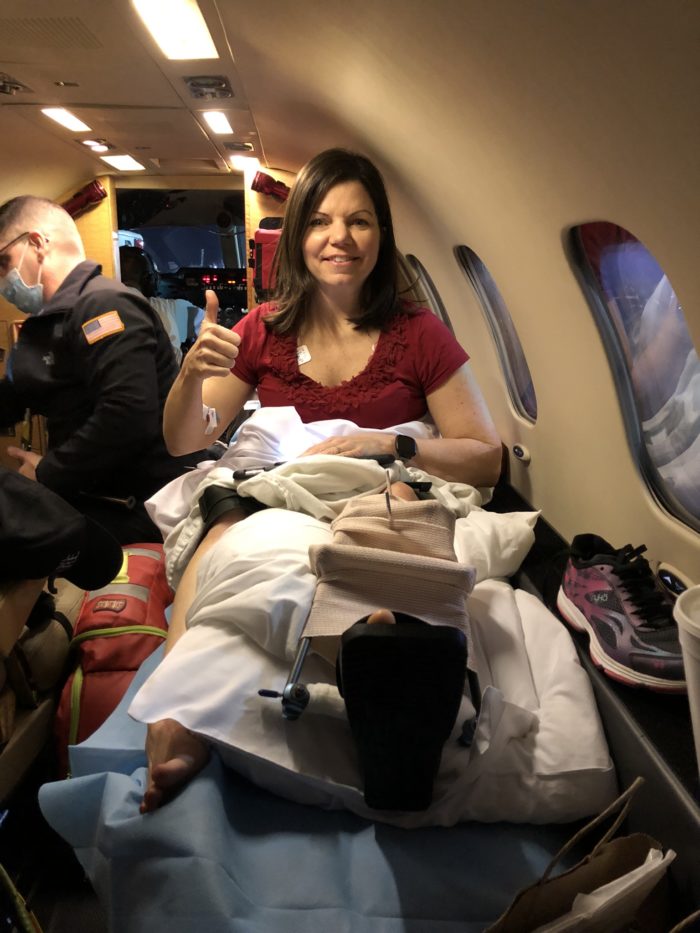
Despres on her way home from San Antonio to Jacksonville, Fla.
Recovery from that point continued to have its challenges.
Several roadblocks presented themselves at the hospital in Jacksonville, including spending a night in the trauma emergency hallway area while hoping a patient room would become available.
Despres had received so many IV lines between the two hospitals that she still had bruises on her arms eight weeks post-surgery.
She found x-ray imaging from the initial intake in San Antonio was missing from her files.
She had to make several phone calls to get certain medications filled on time.
“When I was discharged, it became abundantly clear I was limited in a lot of ways. I was limited in my ability to get dressed, to bathe independently and to manage simple tasks,” she said.
Her husband did what he could while also running his own business, but Despres needed more assistance. Her father stepped in. After the unexpected death of his wife last fall, the family was grieving, but he embraced the opportunity to give Despres the hands-on assistance she needed for several weeks following her second surgery in Jacksonville.
“Getting in and out of cars was difficult. Getting in and out of bed was difficult. Getting up from the chair was difficult. I couldn’t make a meal, because I couldn’t stand independently,” Despres explained. “My father, who was dealing with the loss of my mom, came every single day at five or six a.m. He helped me everything until my husband came home in the afternoon.”
Despres has faced many trials in her journey thus far, but there have also been triumphs.
For starters, the team at One Call has given her unyielding support. From day one, they eased her mind about care and equipment needed and told her to focus on healing.
“The workers’ compensation component happened within two hours of injury. After I talked to my colleague, she reached out to our senior vice president who called me and said, ‘This will be taken care of under work comp. You’re on a work trip.’ And she spoke with someone in the emergency room to give them all the pertinent information,” Despres said.
“She did my first notice of injury right away and started making phone calls.”
The One Call team was also quick to help set up accommodations for Despres at home. By the time she was discharged in Jacksonville, a ramp had already been installed at her house. A shower chair had been delivered. Arms for the commode had been sent. Her workload had been distributed amongst her co-workers so she could heal before returning to work remotely.
And above all, Despres’ experience has taught her a lot about the industry she works in every day.
“I have a new perspective on workers’ comp,” she said. “I’ve learned many lessons that I believe will help us improve our industry and better serve injured workers.”
And what are those lessons, exactly? Despres shares her insights in part two of this two-part series. &
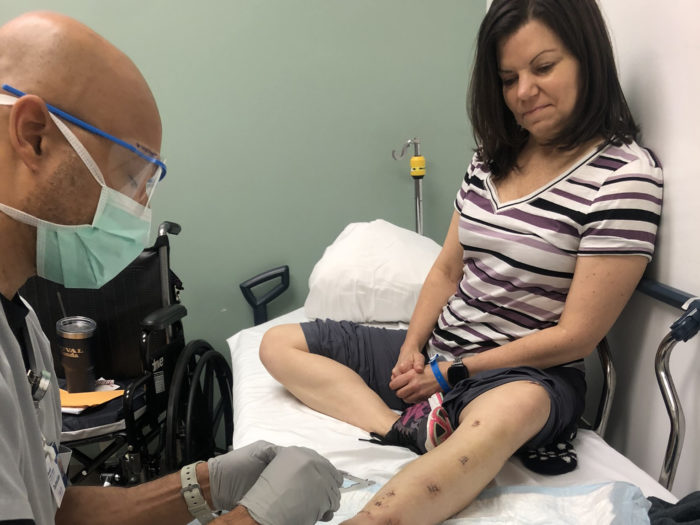 3 Lessons This Workers’ Comp Professional Learned After Shattering Her Leg on the Job
3 Lessons This Workers’ Comp Professional Learned After Shattering Her Leg on the Job
In part two of this two-part series, Michelle Despres of One Call shares the critical workers’ compensation lessons she learned after breaking her leg during a business trip. Read more here.





